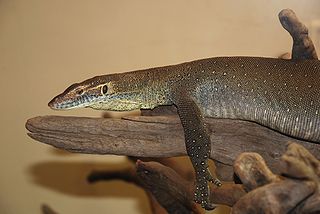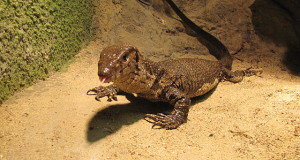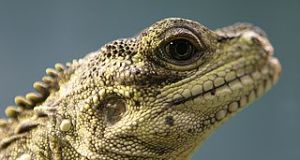Although the Black Rough Neck Monitor, Varanus rudicollis, is rarely-seen in the wild, captive-bred individuals are often available. This striking lizard utilizes a variety of very different habitats, so in a suitably large enclosure one can expect to see a many interesting behaviors. This is definitely a species worth studying carefully, as we still have much to learn. I’ve always wanted to feature them in large zoo exhibits, but was not able to drum up much interest, unfortunately. Private keepers, however, have added greatly to what is known of this under-appreciated monitor.
Black Rough Neck Monitors remind me of Merten’s Water Monitors, Vanaus mersentsi, in general body form and especially in their ability to move about in trees, water and on land with equal ease (Note: the photo below is of a Merten’s Water Monitor; please click here for photos of Rough Neck Monitors)
Range
The Black Rough Neck Monitor is found across a huge range that extends from southern Myanmar through Thailand and western Malaysia to Sumatra and Borneo, and also inhabits nearby offshore islands. As it is difficult to observe, many believe that the range is greater than generally accepted.
Habitat
Although widely distributed, the Black Rough Neck has specific habitat requirements. It seems restricted to rainforests near permanent water bodies and mangrove swamps. Although believed to be highly arboreal, Black Rough Necked Monitors frequently forage on the ground and in the shallows of rivers and swamps.
Description
The Black Rough Neck Monitor is stout in build and averages 3-4 feet in length, with some individuals reaching 5 feet. The body color ranges from dark gray to nearly black; there is some evidence that different populations exhibit specific shades of gray or black. The thick, pointed scales that encircle the neck are unique among monitors; I’ve not yet found a reputable published account of their function. Extremely sharp claws (even by monitor standards!) assist it in climbing.
Enclosure
Like most monitors, Black Rough Necks are quite active, and will not thrive in close quarters. Adults require custom-built cages measuring at least 6 x 4 x 6 feet; greater height is preferable.
Cypress mulch or eucalyptus bark may be used as a substrate. Shy by nature, they are best provided with numerous caves, cork bark rolls and hollow logs in which to shelter, and stout climbing branches for climbing. They prefer sheltering above ground (wild individuals often utilize tree hollows), so a cork bark roll or large nest box positioned among the branches would be ideal.
The cage should be located in a quiet, undisturbed area of the home, as Black Rough Neck Monitors are very aware of their surroundings and easily stressed.
Temperature
Black Rough Neck Monitors fare best when afforded a wide temperature gradient, such as 75-95 F; a dip to 70-73 F at night may be beneficial. The basking temperature should be kept at 120-140 F; some keepers go as high as 150F. Incandescent bulbs http://www.thatpetplace.com/spot-day-white-bulbs may be used by day; ceramic heaters http://bitly.com/NSUMSq or red/black reptile “night bulbs” http://bitly.com/MS35s9 are useful after dark.
Provide your monitor with the largest home possible, so that a thermal gradient (areas of different temperatures) can be established. Thermal gradients, critical to good health, allow reptiles to regulate their body temperature by moving between hot and cooler areas. In small or poorly ventilated enclosures, the entire area soon takes on the basking site temperature.
Humidity
Humidity should average 60-85%, but dry areas must be available. A commercial reptile mister will be helpful if your home is especially dry. A water area large enough for soaking must be available.
Light
UVB exposure is essential. If a florescent bulb is used (the Zoo Med 10.0 UVB Bulb is ideal), be sure that your pet can bask within 6-12 inches of it. Mercury vapor and halogen bulbs broadcast UVB over greater distances, and provide beneficial UVA radiation as well.
Diet
The few available studies and observations indicate that wild Black Rough Neck Monitors take a wide variety of prey animals, and that the diet may vary across the range. Rodents, bats and other mammals, although consumed when available, do not comprise the bulk of the natural diet. Wild individuals seem to feed primarily upon grasshoppers, roaches and other large insects, frogs, crabs, and snails. Scorpions, termites, birds and their eggs, and fish have also been recorded as being consumed.
A rodent-only diet will not work well for Rough Necked Monitors. Youngsters should be fed largely upon roaches, super mealworms, snails, hornworms and other invertebrates, along with small whole fishes, un-shelled shrimp, fiddler and green crabs, crayfish and squid. Mice should be provided once weekly, and hard-boiled eggs can be used on occasion. All meals offered to growing monitors should be powdered with calcium, and a high-quality reptile vitamin/mineral supplement should be used 3x weekly. I favor ReptoCal, ReptiVite and ReptiCal.
Rodents and whole fish can comprise 50% of the adult diet, with a variety of large insects, hard-boiled eggs, crayfish, squid, shrimp, snails and similar foods making up the balance. Calcium and vitamin/mineral supplements should be used 1-2x weekly. Large food items should be avoided; even where adult monitors are concerned, mice are preferable to small rats.
Temperament
Although not a species for beginners, Black Rough Neck Monitors adjust well to captivity when given proper care, and make fine, long-lived pets. Initially shy, some learn to trust gentle caretakers, while others remain wary even after years in captivity. A large, well-furnished cage will provide the security which is essential if they are to become approachable.
In common with all monitors, they are capable of inflicting serious injuries with their powerful jaws, long tails, and sharp claws. Thick leather gloves should be worn when handling Black Rough Neck Monitors, as even tame individuals will cause deep scratches with their claws in the course of their normal movements.
Breeding:
A single male can be housed with 1 or 2 females, but they must be watched carefully. The nesting area should be enclosed (i.e. a large tub or plastic storage container within a wooden box equipped with a single entrance hole) and stocked with 2-3 feet of a slightly moist mix of sand and top soil or peat moss.
Egg deposition generally occurs within 35-50 days of mating, but captive conditions can greatly affect the gestation period. Clutches contain 4-15 eggs, which may be incubated in moist vermiculite at 85-90 F for 180-200 days. Double and triple-clutching has been recorded. Hatchlings measure 8-11 inches in length and are attractively banded with yellow.
Further Reading
 That Reptile Blog – Reptile, Amphibian and Exotic Pet Care and Information
That Reptile Blog – Reptile, Amphibian and Exotic Pet Care and Information






